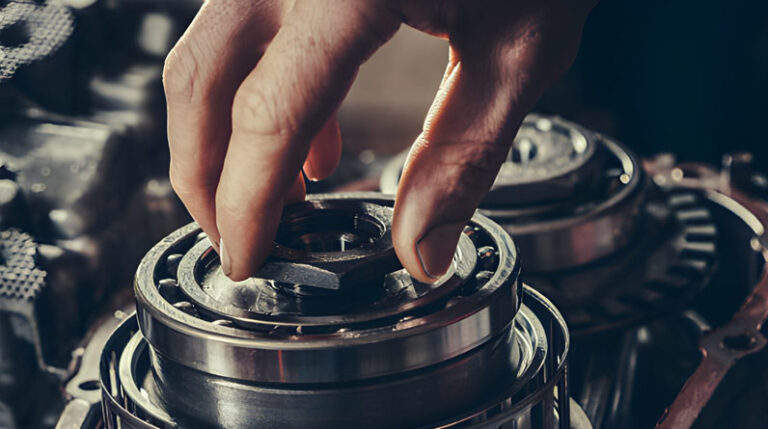What is 2RSB9053?

The designation 2RSB9053 refers to a specific bearing model (or at least a bearing part code) used in mechanical systems. According to multiple published guides, this code is tied to a sealed ball bearing of the “two rubber seals” type, designed to provide long‑life, low‑maintenance operation. Breaking the code down:
-
The “2RS” element typically stands for two rubber seals (one on each side of the bearing) — meaning the bearing is sealed on both sides to keep lubricant in and contaminants (dust, moisture) out.
-
The “B” may indicate a particular design or series variant (for example, a design revision or special internal geometry).
-
“9053” likely corresponds to the size/series number (inner/outer diameter, width, load rating) as defined by the manufacturer.
Thus, the 2RSB9053 bearing is best understood as a sealed bearing (pre‑lubricated, maintenance‑friendly) built for moderate to demanding mechanical applications.
Table of Contents
ToggleKey Technical Features and Specification Considerations
When specifying a bearing like 2RSB9053, it is essential to understand the technical attributes that govern its performance and suitability. Based on available guides:
Sealing and Lubrication
-
The “2RS” double rubber seal arrangement ensures that the bearing is protected on both faces from external contamination (dust, moisture) while retaining the internal lubricant. This improves lifetime and reliability especially in harsher environments.
-
These bearings are typically pre‑lubricated for life, meaning no periodic re‑greasing is required under normal conditions. The sealed design prevents ingress of contaminants that might degrade the lubricant.
-
Because of the seal, there may be a slight trade‑off in maximum speed (RPM) due to seal friction, compared to open or lightly shielded bearings.
Load Capacity & Types
-
While some sources describe the 2RSB9053 as a deep groove ball bearing (primarily radial loads, some axial) others suggest it may belong to the double‑row angular contact ball bearing family (capable of combined radial + thrust loads) depending on manufacturer variant.
-
Key parameters to check on the datasheet:
-
Basic dynamic load rating (C) – for continuous operation.
-
Basic static load rating (C₀) – for stationary or slowly moving loads.
-
Axial load rating (if the application has thrust loads).
-
Speed rating (max allowable RPM) — sealed bearings may have slightly lower speed limits.
-
-
Dimensions: inner diameter (bore), outer diameter, width — must match shaft/housing.
Environment & Operating Conditions
-
Typical temperature range might span ‑40 °C to +120 °C depending on seal and grease formulation. The seal material (e.g., nitrile vs. fluoroelastomer) is important for high‑temperature or chemically aggressive environments.
-
Moisture, dust, chemical vapours reduce bearing life—even sealed designs should avoid extreme contamination or damage.
Life & Reliability
-
Because the bearing is sealed, one of its major advantages is extended service life with minimal maintenance. Some industrial case studies suggest bearings of this type reduce downtime and maintenance interventions significantly.
-
However, even sealed bearings fail if overloaded, mis‑installed or exposed to harsh environments, so proper specification and installation remain critical.
Applications: Where 2RSB9053 Is Used
Given its characteristics (sealed, robust, capable of moderate to high loads, designed for minimal maintenance), the 2RSB9053 bearing finds usage in a variety of industries:
Industrial Machinery & Robotics
In factory automation, robotics and CNC machines, bearings are required to run continuously, precisely and reliably. The sealed design of 2RSB9053 makes it suitable for applications such as:
-
Robotic arm joints (requiring smooth motion, minimal vibration).
-
Gearboxes, conveyor rollers, spindles where contamination from dust/chips is present.
-
Automated assembly lines which operate 24/7 and where maintenance access is limited.
Automotive & Transportation
While perhaps not in heavy engine bearings, the 2RSB9053 is likely found in auxiliary systems such as:
-
Electric motors for windows/adjusters, fans.
-
Alternators or small motor applications where sealed bearings help in harsh under‑hood or exterior environments (dust, moisture).
-
Drive systems or wheel hubs in equipment rather than primary engine bearings.
Aerospace, Medical and Precision Equipment
For applications requiring high reliability under environmental extremes:
-
Aircraft flight‑control actuators, stabilisers or landing‑gear linkages (where the sealed bearing needs to perform under varying temperature/humidity).
-
Medical equipment: imaging systems, surgical robots, where quiet and precise motion is essential and contamination must be avoided.
-
Laboratory equipment: high‑speed spindles, rotary stages where sealing and lubrication retention are advantageous.
Consumer & Home Appliances
Because the sealed bearing requires less maintenance and prevents ingress of dust or lint, it also finds its way into:
-
High‑end blender or mixer motors, vacuum cleaners, fans.
-
Sliding mechanisms, drums in washing machines, where ingress of moisture or lint could degrade a standard open bearing.
In short, the 2RSB9053 bearing is everywhere from heavy industry to everyday appliances — anywhere reliability, minimal maintenance and protection against contaminants matter.
Advantages & Why One Might Choose 2RSB9053
Here are the key advantages of selecting a bearing like 2RSB9053:
-
Maintenance‑free operation: Because of the sealed design, there is little or no need for periodic greasing, reducing maintenance labour and downtime.
-
Protection against contamination: The double rubber seals prevent dust, moisture and other contaminants entering the bearing, extending life and improving reliability.
-
Extended service life: With proper installation and correct specification, these bearings last longer than open bearings in harsh conditions. Some case studies note major reductions in downtime.
-
Reduced risk of failure: Fewer interventions, less contamination = less risk of bearing burn‑out, breakdowns, and associated cost of collateral damage.
-
Cost‑effective over lifecycle: While initial cost may be higher than a basic open bearing, the total cost of ownership (including labour, downtime, replacements) often favours the better sealed bearing.
Common Pitfalls & How to Avoid Them
Even though 2RSB9053 is a robust choice, making the right selection and doing the installation properly is vital. Common mistakes include:
Mistake 1: Wrong specification
Selecting a bearing based only on size (inner/outer diameter) but ignoring load ratings, axial load capability, speed, or environment.
Solution: Always refer to the manufacturer’s datasheet, checking dynamic/static load ratings, axial capacity (if needed), speed rating and suitability for the environment.
Mistake 2: Ignoring the environment
Even sealed bearings can fail early if exposed to extreme contamination, chemical vapour, high temperature beyond spec or mechanical overload.
Solution: Evaluate environmental conditions — moisture, dust, chemicals, temperature extremes — and choose the correct seal material and bearing design accordingly.
Mistake 3: Improper installation
Bearing life can be drastically shortened by mis‑installation: misalignment, pressing force applied incorrectly, surface damage, inadequate shaft/housing fit.
Solution: Use proper tools (press, induction heating, sleeves), apply force only to the correct ring, verify fit (shaft/housing tolerances), and ensure cleanliness at installation. Many failure‑analysis studies show installation error is one of the largest failure causes.
Mistake 4: Overlooking hidden costs
Choosing a cheaper bearing may save upfront but cost much more in maintenance, replacement and downtime.
Solution: Consider total cost of ownership (initial cost + maintenance + downtime + failure risk) rather than only purchase price.
Installation & Maintenance Best Practices
Pre‑installation checklist
-
Confirm the part number (2RSB9053), correct dimensions, load ratings and seal type.
-
Inspect shaft/housing: clean thoroughly, check for burrs, scratches or contamination.
-
Ensure correct temperature range, alignment, and fit tolerances.
-
Ensure no damage to bearing (inspect packaging, seals, rings).
-
Use proper tools (presses, sleeves, induction heaters if needed) and ensure the correct ring is the one receiving mounting force.
Mounting the bearing
-
If mounting on a shaft: apply force to inner ring, not the outer ring, so that the load does not pass through the rolling elements.
-
If inserting into a housing: apply force to outer ring only.
-
Using thermal methods (heating bearing or cooling shaft) can help when interference fits are involved — but be careful not to overheat (especially seals). Some manufacturers advise staying below ~120 °C for rubber‑sealed bearings.
-
After installation, manually rotate the shaft to check smoothness, confirm proper seating, absence of binding or abnormal noise.
Post‑installation monitoring & maintenance
-
Even sealed bearings benefit from periodic checks. Monitor for noise, abnormal vibration, elevated temperature, or increased current draw (in motorised applications).
-
Use vibration analysis (if available) and temperature monitoring to detect early failure signs.
-
If any abnormal signs appear (grinding noise, overheating, progressive vibration), schedule replacement before catastrophic failure to avoid damage to other components.
Replacement criteria
-
If the bearing shows signs of internal damage (excessive noise, play, vibration) or if the equipment’s performance degrades, replacing the bearing promptly is recommended.
-
Because 2RSB9053 bearings are sealed and pre‑lubricated, relubrication is not recommended — opening the seal risks contamination and exposes the lubricant to dirt.
Comparison with Other Bearing Types
Sealed (2RS) vs. Open Bearings
Sealed bearing (like 2RSB9053) • Better contamination protection • Pre‑lubricated • Lower maintenance • Slightly lower maximum speed due to seal friction
Open bearing • No sealing – lubricant visible • Requires periodic relubrication • Higher maximum speed possible in clean conditions
Thus, for harsh or dusty environments, sealed bearing is generally the better choice.
Sealed (2RS) vs. Shielded (ZZ)
Shielded (ZZ) bearings have metal shields (not rubber) which protect against larger particles but not fine dust or moisture as effectively.
Double rubber sealed (2RS) offers a more complete barrier; preferred where moisture or fine contaminants are present, albeit with a small speed reduction.
Selecting between them depends on the environment, required speed, maintenance regime, and cost.
Lifecycle & Cost Analysis
Understanding the cost implications of bearing choice can influence specification decisions. For example:
-
A lower‑cost open bearing may cost less initially, but may require relubrication, more frequent replacement, more frequent downtime.
-
A 2RSB9053 sealed bearing may cost more up front, but reduce maintenance, downtime, and failure risk — giving a lower total cost of ownership.
Some published case studies show that replacing open bearings with sealed bearings (in critical production machinery) reduced maintenance interventions by 50‑60 %, downtime fell significantly and ROI was achieved in under one year.
When modelling lifecycle cost, include: purchase price, installation labour, maintenance labour, downtime cost per hour, bearing failure risk and collateral damage cost.
Future Trends & Outlook
While 2RSB9053 represents a high‑quality sealed bearing in current practice, the bearing industry continues to evolve. Some trends likely to influence the future include:
-
Smart bearings: Embedded sensors inside bearings monitoring temperature, vibration and load in real time; able to report condition and predict failure ahead of time.
-
Advanced materials: Ceramic rolling elements, hybrid bearings for higher speeds or more extreme environments; improved seal materials (for higher temperature/chemical resistance).
-
Digital twin / simulation: Virtual models of bearing performance under real loads and varying conditions; enabling better selection and lifetime prediction.
-
Greater emphasis on sustainability: Bearings designed for longer life, easier recycling, lower maintenance, less lubricant waste.
When specifying 2RSB9053 today, it’s wise to consider how newer technologies may influence replacement choices and lifetime planning.
Frequently Asked Questions (FAQ)
Q: Does “2RS” always mean double rubber seal?
A: In bearing nomenclature, “2RS” typically does indicate two rubber seals — one on each side. In the case of 2RSB9053 this appears to hold true.
Q: Can a 2RSB9053 bearing be relubricated?
A: Generally no — the sealed design is intended to be maintenance‑free. Opening the seal may compromise the protection and allow contamination. The manufacturer’s datasheet should be consulted.
Q: Is 2RSB9053 interchangeable with other bearings?
A: Only if the dimensions, load ratings, speed ratings, and sealing type all match. Substituting blindly may shorten life or cause failure. Always confirm with bearing manufacturer/distributor.
Q: What are the signs that I need to replace a 2RSB9053 bearing?
A: Indicators include increased noise (grinding, rumble), vibration, elevated bearing or motor temperature, increased current draw in motor applications, or performance drop in mechanism. Early replacement avoids damage to adjacent components.
Q: How do I ensure I’m buying an authentic 2RSB9053 bearing?
A: Verify manufacturer markings, check packaging quality, ensure datasheet is included, use reputable distributor. Counterfeit or low‑quality bearings may fail prematurely.
Conclusion
The 2RSB9053 bearing is a technically sound choice when a sealed, low‑maintenance, robust bearing is needed—particularly in environments where contamination (dust, moisture), moderate-to-high loads, and reliability are key. The “2RS” designation gives away the sealed nature; the series “B9053” marks the size/design variant. Proper specification (load, speed, dimension), correct installation and monitoring are vital to get the expected service life.
While upfront cost may be higher than a basic open bearing, the advantages — reduced downtime, longer intervals between maintenance, improved reliability — often make the sealed bearing a better investment over the life of the machine. As bearing technology continues to advance, integrating smart monitoring, improved materials and simulation-driven design will further enhance performance. But the fundamental engineering principle remains: match the bearing to the application, install it correctly, monitor where appropriate, and replace when necessary.
In your selection of bearings, if you come across 2RSB9053, you now have the information to understand what it is, where it fits, how to install it, and why you might choose it. Whether you’re an engineer, maintenance manager or procurement professional, this knowledge will help ensure your systems run smoother, longer, and with fewer interruptions.
If you’d like, I can check typical dimensional data (inner diameter, outer diameter, width), load ratings or global sourcing options for the 2RSB9053 bearing and compare major brands. Would you like me to do that?













Post Comment